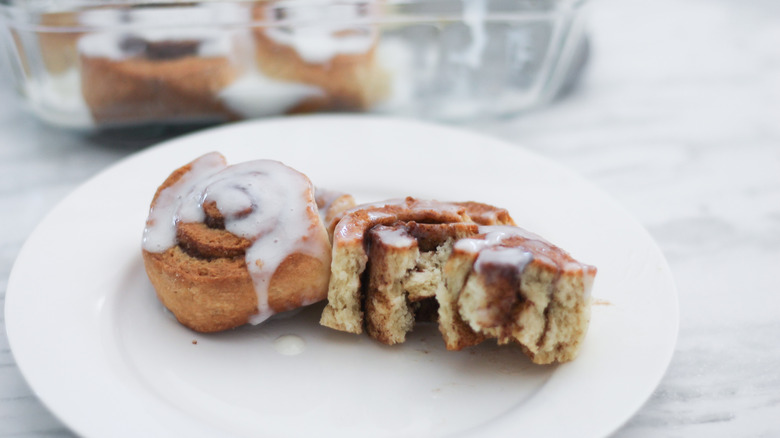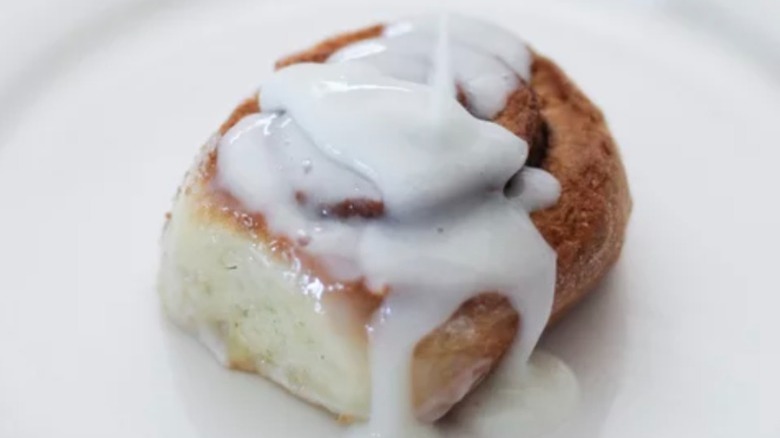The Unexpected Ingredient That Will Majorly Upgrade Your Cinnamon Rolls
Warm from the oven and dripping with icing, cinnamon rolls are the special-occasion breakfast that's more like a dessert. Brought to the United States by German and Swedish immigrants in the 17th century, cinnamon rolls are called coffee scrolls, cinnamon buns, or cinnamon snails, depending where you live.
The yeasty dough is rolled into a rectangle before being covered with cinnamon, sugar, and butter. The dough is then rolled into a log before being cut into pinwheels. Once baked, the rolls are often iced with a cream cheese frosting, although some frost the rolls with a coffee-flavored fondant or honey (per Serious Eats). Cinnamon buns, meanwhile, are prepared the same way as cinnamon rolls but contain nuts.
Cinnamon rolls are so loved in Sweden that the country declared October 4 to be "Cinnamon Roll Day." And why not? The brunch favorite is delicious, and the aroma of rolls baking in the kitchen is one of the most wonderful ways to wake up. People also enjoy cinnamon rolls while shopping thanks to Cinnabon, which has more than 1,600 stores globally. The franchise has been baking its cinnamon rolls since 1985, when the first Cinnabon opened in the "SeaTac Mall" in Seattle, Washington.
The time it takes to prepare cinnamon rolls had previously relegated the treats to special occasions. But Melissa Olivieri has created a recipe that doesn't require the dough to proof for hours, meaning we could bake a batch of cinnamon rolls in the morning without starting at 3 a.m.
The upgraded cinnamon roll recipe
Voted "Recipe of the Year" in 2021, King Arthur Baking makes its cinnamon rolls the traditional way using yeast, the live fungus responsible for making bread rise. As the yeast feeds on sugars in the dough, it releases carbon dioxide, expanding the dough. This reaction creates a fluffy roll, keeping baked goods from being dense. Unfortunately, yeast requires time to do its thing, adding one to two hours to your baking. To reduce that time, recipe developer Melissa Olivieri removed yeast from her cinnamon roll recipe. She replaces it with Greek yogurt, which keeps the rolls moist while saving the baker two-and-a-half hours in the kitchen.
The upgraded recipe promises to get warm cinnamon rolls on the breakfast table in under 30 minutes. (That's the same time it takes to unwrap, pop, and bake Pillsbury's canned cinnamon rolls.) Bakers can prepare the recipe ahead of time and refrigerate the unbaked dough for a few days or freeze it for up to a month. Bake the rolls directly from the freezer, adding a few minutes to the baking time. Olivieri also uses yogurt in the icing, skipping the cream cheese for a better-for-you alternative.
Although homemade treats are almost always tastier than the processed alternatives, Pillsbury's website does offer some delicious-looking ideas using cinnamon roll dough. Check out the "Monkey Bread" and "Cinnamon Roll Waffle" recipes for inspiration for Olivieri's upgraded cinnamon roll dough. Your family will thank you.

